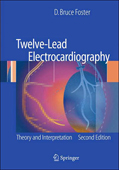There are two components to the complete interpretation of an
electrocardiogram (ECG): analysis of the rhythm of the ECG waveforms
which are the electrical manifestation of cardiac activity; and
analysis of the shape (morphology) of the waveforms in order to
diagnose many conditions not related to rhythm. Twelve Lead
Electrocardiography: Interpretation and Theory deals solely with this
second component, and is aimed at students who already have a
familiarity with the analysis of heart rhythms.
Twelve Lead Electrocardiography for ACLS Providers describes a set of
discrete building blocks of easily understood electrophysiologic
principals, and then allows the reader to deduce what the 12 lead
electrocardiogram will look like under various circumstances. There
is no memorizing patterns. Instead emphasis is on understanding and
deduction. Retention is greatly enhanced, and more importantly, the
reader becomes a more competent interpreter of 12 lead ECGs.
The ultimate objective of the text is to enable both cardiologists
and non-cardiologists to utilize the 12 lead ECG in daily clinical
practice in a competent manner. Cardiology residents, students,
emergency physicians and internists, as well as paramedics, physician
assistants, and nurse practitioners who are called upon to make
initial clinical judgements particularly regarding the evaluation of
patients with chest pain will all benefit from the information
contained within these pages.
차 례
Essential Cardiac Anatomy and Physiology as it Relates to the
Electrocardiogram.- Electrocardiographic Waveforms.- 3 Cardiac
Vectors and Lead Systems.- Derivation of the Normal
Electrocardiogram.- Electrical Axis.- Intraventricular Conduction
Delays: The Hemiblocks.- Intraventricular Conduction Delays: The
Bundle Branch Blocks.- Chamber Enlargement.- Myocardial Infarction.-
Ischemia and Anginal Syndromes.- The ECG and the Clinical Evaluation
of Chest Pain.- The ACLS Provider and Therapeutic Interventions in
Acute Myocardial Infarction.- Miscellaneous Conditions.- Case
Presentations.


